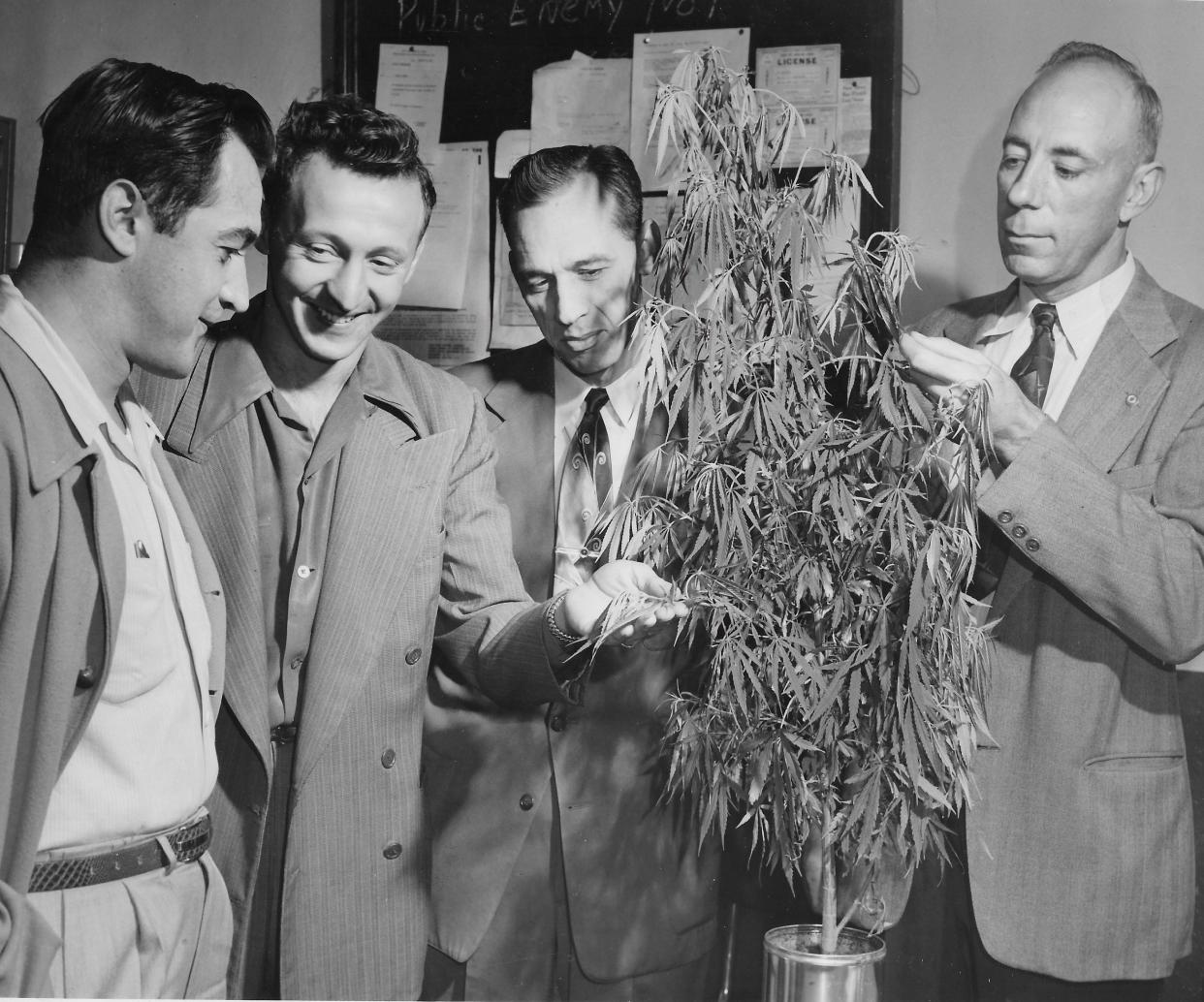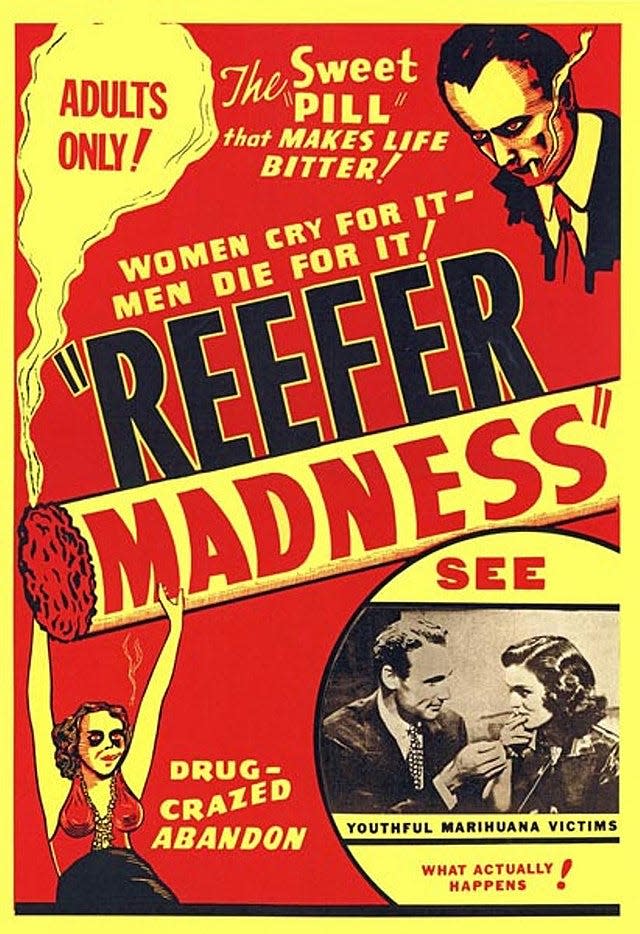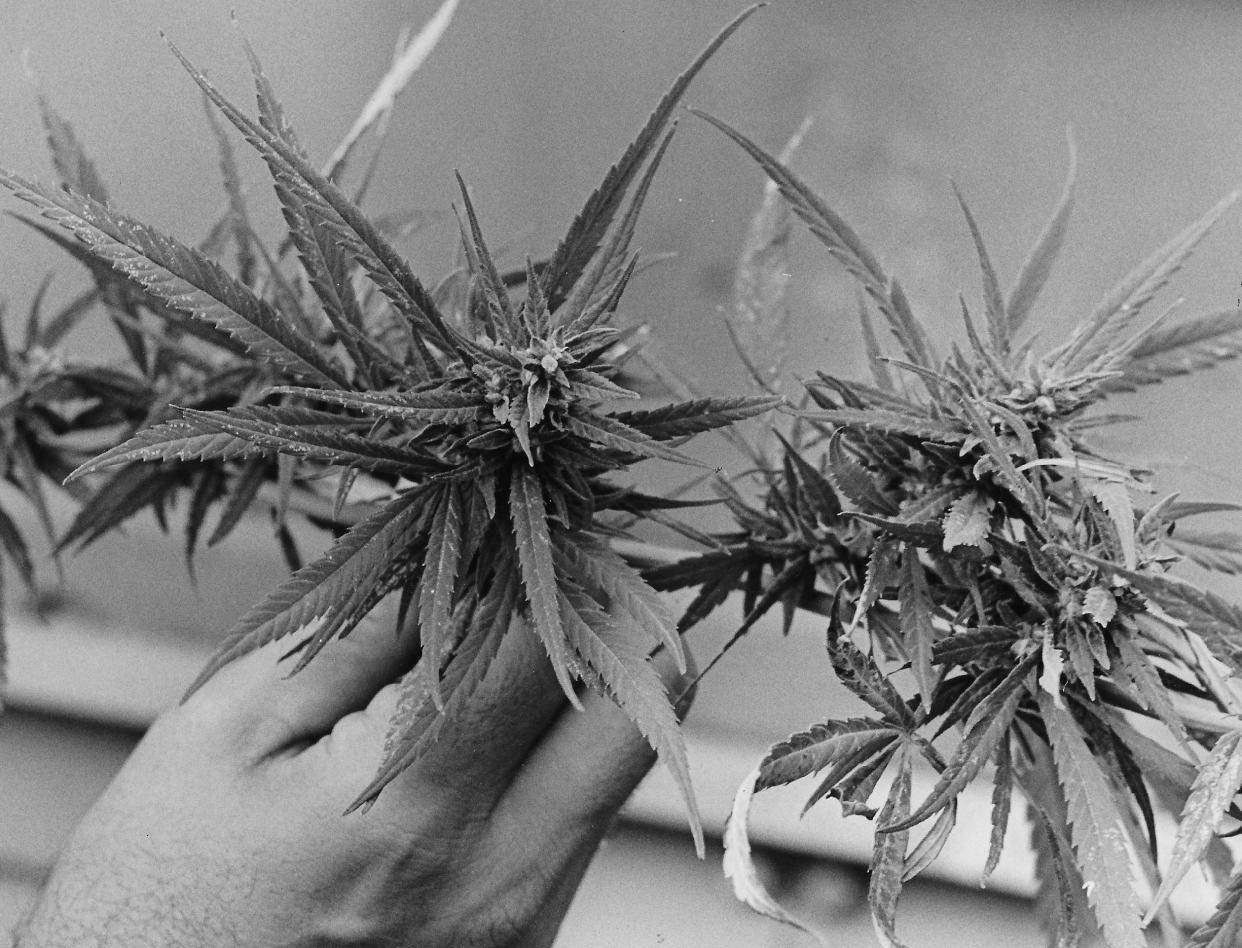Local history: Akron experienced reefer madness in 20th century

Our ancestors would be in total disbelief.
Ohio has voted to legalize marijuana for adult recreational use?
All they ever heard about “the devil’s weed” was how it led to moral corruption, criminal behavior and violent insanity.
A century ago, Akron residents read with growing concern as a mysterious drug began to crop up across the country. In 1921, a Beacon Journal article noted: “Many Mexicans in the Arkansas valley are reported to have been made insane from smoking ‘Indian hemp,’ and an extensive traffic in the ‘loco weed’ has been going on in some sections of Colorado.”
In 1925, hundreds of acres of “hashish weed” were reported to be growing wild throughout Kansas. Boys and girls were buying cigarettes “adulterated with the weed” and throwing parties.
“Use of this drug, which leads to violent insanity, has invaded our high school in Hutchinson,” Reno County Sheriff Jesse Langford lamented.
Marijuana, originally spelled “marihuana” or “mariguana” in the United States, had street names such as “Mary Warner,” “Mary Jane,” “reefers,” “muggles,” “moota,” “griffo,” “kiff” and “Indian hay.”
Chicago authorities blamed the weed for an increase in crime. They said drug peddlers preyed on youths in cabarets and dance halls, persuading them to try the new cigarettes with disastrous results.
“We are getting complaints every day from mothers who claim that their children are acting as if under the influence of drugs,” said L.J. Ulmer, chief of the narcotics division in Chicago.
Akron makes a marijuana bust
Akron was late to the party, but marijuana eventually made its way here from Cleveland via New York and Chicago.
“A quantity of marihuana, a Mexican dope reputed to drive users insane in about five years, had been seized Saturday by the vice squad and two men were under arrest as being suspicious persons following a raid on a house at 937 Bank St.,” the Beacon Journal reported June 2, 1934.
Pete Alvarado, 35, and John Bruno, 40, were arrested in the raid, which confiscated $50 worth of weed, 100 rolled cigarettes and a loaded gun. The reefers sold for $2 a dozen — or about $45 today.
Experts said smokers initially felt a rush of euphoria, followed by a deadening of the senses and then headaches, nausea and jitters. Continued use led to a “tendency to commit crime.” Marijuana addicts “sometimes are so unbalanced mentally that color sensations are received through the ear instead of the eye,” one critic noted.
A 15-year-old Akron girl, caught smoking in a nightclub, told police she wanted “to get extra pep.” An East Akron druggist acknowledged selling cannabis but denied knowing that customers used it for cigarettes.
In 1935, Ohio adopted the Uniform Narcotic Drug Act to prohibit the production of narcotic drugs within state borders. Federal rules tightened.
Akron Mayor Lee D. Schroy announced a crackdown “on the vicious marijuana traffic” in 1937. Four undercover agents patrolled high schools and the University of Akron to thwart drug peddlers.
“The weed is being grown in Akron and nearby and we’re doing everything we can to stamp it out,” Schroy said.

“It’s a habit-forming drug, and we should raise the cry to high heaven here so parents will know just what an evil it is,” Akron Councilman Edmund Rowe announced at a City Council meeting. “It is my understanding that use of this weed produces a feeling of exhilaration, and after boys and girls smoke one, they return for more. Soon they’re hunting for money to buy them, and in that way we start them on a downward path that leads to crime and degradation.”
Despite raids across the city, authorities could not root out cannabis. A 1937 photograph shows Akron vice officers pulling the wrong weeds from a field, unsure what they were there to find.
Akron City Council passed a 1938 ordinance prohibiting the sale, possession and manufacture of cannabis and other narcotics without a license from the Ohio Board of Pharmacy. Violators faced a $500 fine and six months in jail.

‘Reefer Madness’ and other films
Akron theaters screened exploitation films like “Reefer Madness,” “Marihuana,” “The Devil’s Weed” and “Assassin of Youth.” On the surface, the melodramas excoriated the use of cannabis, but some authorities believed audiences were getting the wrong message.
Akron Municipal Judge Clande V.D. Emmons singled out “Assassin of Youth” in 1938 as being particularly loathsome.
“I see no earthly reason why it should be shown,” Emmons said. “Rather than deter young people from using marijuana, I think it encourages them to try it. It tends to immorality, if anything. All the picture shows is a bunch of college kids getting drunk on the weed.
“Why don’t they show the real evils of marijuana? Why don’t they go into the penitentiaries and show the people who are there because they committed a crime under the influence of the weed? That would be a real education.”
In 1940, the Beacon Journal published a tip from linguist Frank Colby on how to pronounce marijuana.
“Accent the first and third syllables,” he explained. “The ‘a’s’ are broad as in father. The ‘j’ has the sound of ‘h’ strongly aspirated. Correct pronunciation: MAH-ree-HWAH-nah.”
Which, of course, wasn’t really the way to pronounce it, but ... oh, well.
Even the funny pages entered the discussion. In a 1945 panel of the comic strip “Kerry Drake,” a district attorney asked the detective: “What’s the charge this time?” Drake’s reply: “You’ve got a choice of marihuana peddling or murder! One’s about as nice as the other.”
Some people blamed musicians for corrupting the youths of America.
“Most reefer smokers are found among musicians and other artists,” correspondent Douglas Larsen wrote. “The drug has its greatest appeal to persons of unstable personality.”
And wouldn’t you know it? Two Los Angeles musicians from Alvino Rey’s orchestra were arrested in 1948 on drug charges following the group’s concert at East Market Gardens in Akron. The two men were busted at the Anthony Wayne Hotel after having a courier deliver reefers to their room.
In 1951, Akron patrolman Florian Smole grew two marijuana plants to display at the police station.
“We wanted to be able to identify the weed positively,” Police Lt. Cletus McGuckin said. “We let them grow just large enough so we could study the leaves.”
“All I did was to dig a hole and throw in the seeds,” Smole said.
Police vowed to destroy the exhibit after it had served its purpose.
Dope a ‘communicable disease’
In 1951, the Summit County Federation of Women’s Clubs distributed pamphlets that condemned the “dreadful crime of peddling marihuana.”
“Expert witnesses predict that one in 50 high school students may fall victim of drug addiction which puts youth in touch with the underworld and leads to thieving, prostitution and other crime,” wrote Dorothy Deemer Houghton, president of the national federation. “Narcotic addiction could be stamped out by quarantining the present addicts in hospitals as we quarantine for smallpox.”
By her calculations, each addict caused four other persons to become addicts, and those four made 16 other addicts, “and so on.”
“Dope is a communicable disease,” she concluded.
Fortunately for opponents, marijuana’s popularity plummeted in the 1960s.
Just kidding. The counterculture movement fanned the flames of grass and pot, leading to widespread use among younger generations.

In 1966, the Beacon Journal interviewed two Akron men, 26 and 24, who had been arrested on drug charges. They admitted peddling marijuana, but insisted they had done nothing wrong.
“I sold happiness,” one dealer said. “If you saw as many people as I’ve seen, being twisted, tortured, coerced by their own minds, being strangled by their own constipated egos, you’d try to help them, too.”
“You can’t keep marijuana down,” the other predicted. “Some things you just can’t.”
Drug experiment with mice
In 1970, Dr. Edward B. Truitt Jr., a medical researcher at Ohio State University in Columbus, conducted an experiment with two white mice. One he gave pot, the other he did not. The drug-free mouse was upright and alert. The marijuana mouse lay flat on its belly in a stupor.
After spending nearly three years on research, Truitt recommended a wait-and-see approach on the legalization of marijuana.
“The biggest reason for restraint is to see what develops in research,” he told the Beacon Journal. “I can see absolute uproar in the country if it’s legalized and something like damage to children at birth is shown or long-term mental illness develops.”
If marijuana turned out to be harmless physically and mentally, it might fit into the category of a recreational drug, but that was a big if, Truitt said.
“Let’s wait on legalizing it,” he said.
At any rate, he doubted that pot would remain in high demand.
“I think a general use will continue, but the popularity it now has will somewhat decline as people become more hip, more informed of its capacity and limitations,” he said.
More than 50 years later, Ohioans have voted to legalize marijuana for adult recreational use.
If anything goes wrong, we can’t say they didn’t warn us.
Mark J. Price can be reached at mprice@thebeaconjournal.com
More: Oops! Classic bloopers from the collection of Mark J. Price
Mark J. Price: Things I’m old enough to remember about Akron
This article originally appeared on Akron Beacon Journal: Local history: Akron experienced reefer madness in 20th century
